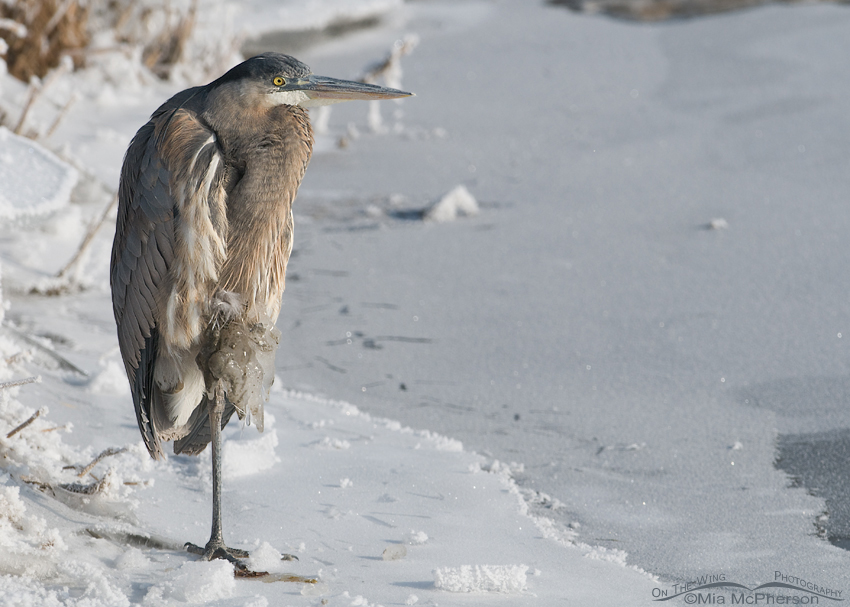Great Blue Heron on ice with ice stuck on its chest feathers.
 Great Blue Heron trying to remove the ice from its breast feathers
Great Blue Heron trying to remove the ice from its breast feathers
In a few posts recently I have mentioned that winter can be hard on the birds in Utah because of very low temperatures and heavy snow. Ice can be a problem for some birds too mainly because when everything is iced over some birds can’t get to their preferred food, for instance American Coots feed on vegetation below the surface and when they can’t get to the food any more they have to leave or die.
But ice can pose other problems too. It might look like this Great Blue Heron is hacking up some type of fluid seen in between and to the left of its bill but that is actually a hunk of ice attached to the heron’s breast feathers. The heron may have spent the night in the water to avoid predators and the ice formed on the breast feathers as it scrunched down to maintain body heat.
That ice? It probably weighs as much as the heron.
 Great Blue Heron on ice with ice
Great Blue Heron on ice with ice
The Great Blue Heron was resting on a shelf of ice when I photographed it and the ice is shown dangling in front of the lower section of the breast here. The heron later was disturbed, not by me, and took flight with that large chunk of ice still hanging from its breast feathers and I saw it struggle to become airborne.
Winter is hard on the birds of Utah.
Life is good.
Mia
Click here to see more of my Great Blue Heron photos plus facts and information about this species.


Maybe they should come to Florida like all the other snow birds
Wow, Mia, I’ve never seen that. This is where my soft heart fails. I would be beside myself not being able to help. Is the heron in an area where if it became immobilized, there might be wildlife rescuers? (I know, I think like a rehabber, but there’s nto always anything we can do.)
I adore these big guys … great, great capture, Mia!!
It certainly is a tough life for them.
This speaks volumes, Mia. It is tough for these birds and possibly deadly.
Thank you for the timely reminder. I moan about the season (summer here) but I really have nothing to complain about. Stunning photo, and I hope the ice on the heron broke away or melted quickly.
That’s an awfully big, heavy hunk of ice for that poor bird to lug around…and it must take a toll on much need energy,
so sad..winter is tough on all wildlife..great photo
Thanks for the reminder of the struggle these and other animals face in winter.
Sad?
It’s learning to skate, great photography Mia.
Wow – I guess I always thought they went “way” south in the winter months. We just had one die at a pond here earlier when it iced over. It had a broken wing.